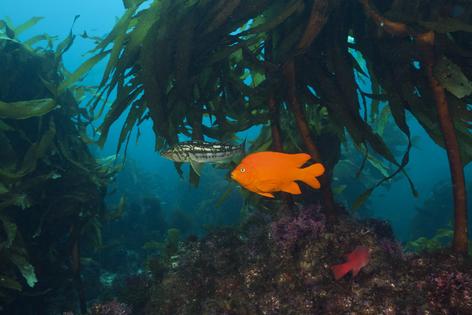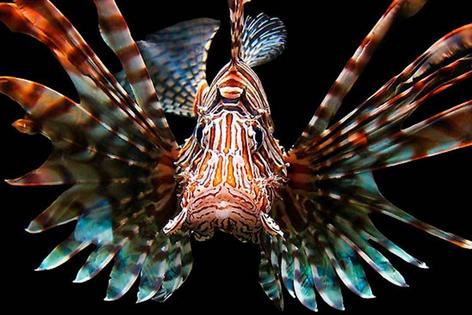Protecting the ocean: 5 essential reads on invasive species, overfishing and other threats to sea life
Published in News & Features
Humans rely on the ocean for many things, including food, jobs, recreation and stabilization of Earth’s climate. But although ocean resources may seem infinite, human impacts like pollution, overfishing and climate change are creating what United Nations Secretary-General António Guterres has called an “ocean emergency.” Climate change is pushing ocean temperatures to record levels, many fisheries are overharvested, and plastic waste is accumulating in the deep sea.
These five articles from The Conversation’s archive spotlight urgent challenges for ocean conservation, and describe what researchers are doing to devise effective responses.
Invasive lionfish are aggressive predators, native to the Indo-Pacific Ocean, that feed on smaller reef fish. They have caused heavy damage in the Caribbean and Gulf of Mexico since they first appeared in the Atlantic in 1985. Now, they’ve spread south to Brazil, which has many rare endemic fish species and is behind the curve in responding.
“As one of many Brazilian scientists who warned repeatedly about a potential lionfish invasion over the past decade, I’m disheartened that my country missed the window to take early action,” wrote Charles Darwin University marine scientist Osmar J. Luiz. “Now, however, marine researchers and local communities are stepping up.”
One important control strategy was to create an interactive dashboard where anyone can report lionfish sightings. Other steps are likely to include environmental education, organized culls and genetic research to identify distinct lionfish populations and see where they’re moving. With a similar lionfish invasion underway in the Mediterranean, there’s urgent need for effective responses.
Read more:
One of the ocean’s potentially most valuable resources hasn’t been tapped yet – but that could be about to change.
Scattered across large zones of the ocean floor, manganese nodules – lumps that look like cobblestones – contain rich deposits of nickel, copper, cobalt and other metals that are newly in demand for manufacturing batteries and renewable energy components.
“A fierce debate is now playing out as a Canadian company makes plans to launch the first commercial deep sea mining operation in the Pacific Ocean,” Indiana University scholars Scott Shackelford, Christiana Ochoa, David Bosco and Kerry Krutilla warned.
Less than 10% of the deep seabed has been mapped thoroughly, and most life forms discovered there have never been seen before. Collecting materials from the ocean floor could harm these species – for example, by burying them in sediments. “We believe it would be wise to better understand this existing, fragile ecosystem better before rushing to mine it,” the authors concluded.
Read more:
Illegal fishing – taking too many fish, or harvesting threatened species – causes economic losses estimated at US$10 billion to $25 billion annually. It also has been linked to human rights violations, such as forced labor and human trafficking. But it’s easy to conduct these activities out of sight on the high seas.
By looking at when and where fishing boats turned off their location transponders at sea, academic and nongovernment researchers showed that these silences can be an important signal.
“Vessels frequently went dark on the high-seas edge of exclusive economic zone boundaries, which can obscure illegal fishing in unauthorized locations,” wrote Heather Welch, a researcher in ecosystem dynamics at the University of California, Santa Cruz.
Ships may also disable their transponders to avoid pirates or avoid drawing competitors to rich fishing sites, so making it illegal to turn their signals off isn’t a practical strategy. But more analysis of where boats go dark could help governments target inspections and patrols, reducing crimes at sea.
Read more:
Just as there are unnumbered life forms in the ocean yet to be discovered, there also are many unanswered questions about its physical processes. For example, scientists know that the ocean pulls carbon from the atmosphere and transfers it to deep waters, where it can remain stored for long periods. But they don’t know how biological and chemical shifts affect this carbon cycling process.
Scientists at the Woods Hole Oceanographic Institution in Massachusetts are designing a monitoring system called the Ocean Vital Signs Network that could make it possible to test strategies for storing more carbon in the ocean and tracking how well they work. They envision “a large network of moorings and sensors that provides 4D eyes on the oceans – the fourth dimension being time – that are always on, always connected to monitor these carbon cycling processes and ocean health,” wrote WHOI director Peter de Menocal, a marine geologist and paleoclimatologist.
The network would include intelligent gliders and autonomous vehicles that could collect data and then dock, repower and upload it. It also would use sensors and acoustic transceivers to monitor dark, hidden reaches of the ocean where carbon is stored. “This network makes observation possible for making decisions that will affect future generations,” de Menocal wrote.
Read more:
Over the past several decades, plastic pollution has become one of the world’s more widespread environmental crises. Every year, millions of tons of plastic trash end up in the ocean, killing sea creatures, smothering ecosystems and threatening human health.
Georgia State University art professor Pam Longobardi grew up in New Jersey, where her father brought home plastic trinkets from his job at the chemical company Union Carbide. Today, Longobardi collects plastic waste from shorelines around the world and sculpts it into large-scale installations that are both eye-catching and alarming.
“I see plastic as a zombie material that haunts the ocean,” Longobardi wrote. “I am interested in ocean plastic in particular because of what it reveals about us as humans in a global culture, and about the ocean as a cultural space and a giant dynamic engine of life and change. Because ocean plastic visibly shows nature’s attempts to reabsorb and regurgitate it, it has profound stories to tell.”
Read more:
Editor’s note: This story is a roundup of articles from The Conversation’s archives.
This article is republished from The Conversation, an independent nonprofit news site dedicated to sharing ideas from academic experts. The Conversation is trustworthy news from experts, from an independent nonprofit. Try our free newsletters.
Read more:
Is there life in the sea that hasn’t been discovered?
In the turbulent Drake Passage, scientists find a rare window where carbon sinks quickly into the deep ocean













Comments